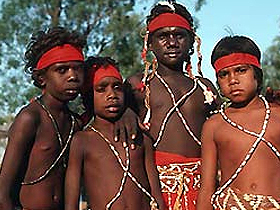 Native Aborigines |
Before Europeans discovered Australia, the only people there were Aboriginals, the descendents of groups who migrated to the north coast of Australia from Southeast Asia 50,000 years ago and who, in time, spread to all parts of the subcontinent.
Before the Europeans came to Australia in 1788, there were some 300,000 Aboriginals living there, divided into 500 tribes. The newly-arrived Europeans regarded them as “primitive” and undertook to exterminate them, employing extraordinarily savage means. By the end of the extermination, there were few Aboriginal survivors from the original 500 tribes. Of the Australian population today, only one in a hundred persons is of Aboriginal ancestry.3
The Europeans’ extermination of the Aboriginals on the pretext that they were primitives gained momentum from the publication of Charles Darwin’s Descent of Man (See, Descent of Man). In this book, he proposed that there was a “struggle for life” among the different races of humanity and that the “fittest” races were those that survived.
According to Darwin, the fittest were white Europeans. Asian and African races fell behind in this struggle. Darwin went further to suggest that they would soon lose their struggle for survival and be totally annihilated:
At some future period not very distant as measured by centuries, the civilized races of man will almost certainly exterminate, and replace the savage races throughout the world. At the same time the anthropomorphous apes . . . will no doubt be exterminated. The break between man and his nearest allies will then be wider, for it will intervene between man in a more civilized state, as we may hope, even than the Caucasian, and some ape as low as the baboon, instead of as now between the negro or Australian and the gorilla.4
As we see, Darwin placed Australian Aboriginals on the same level as gorillas. He did not consider the Aboriginals to be human beings and believed that those who were exterminating them were only killing gorilla-like animals.
After Darwin, some evolutionists stated that “if human beings and apes descended from a common ancestor, there must be somewhere in the world a transitional form (half-human and half-ape) that has still not totally evolved.” (See Transitional form). Because Aboriginals have slightly larger eyebrow protrusions, a more downwardly slanted jaw and a smaller brain volume than Western peoples, they were thought to be living examples of transitional species. In order to produce proofs of evolution, evolutionist paleontologists together with fossil hunters who accepted the same theory dug up Aboriginal graves and took skulls back to evolutionist museums in the West. Then they offered these skulls to Western institutions and schools distributing them as the most solid proof of evolution.
Later, when there were no graves left, they started shooting Aboriginals in the attempt to find proof for their theory. The skulls were taken, the bullet holes filled in and, after chemical processes were used to make the skulls look old, they were sold to museums.
This inhuman treatment was legitimated in the name of the theory of evolution. For example, in 1890, James Bernard, chairman of the Royal Society of Tasmania wrote: “the process of extermination is an axiom of the law of evolution and survival of the fittest.” Therefore, he concluded, there was no reason to suppose that “there had been any culpable neglect” in the murder and dispossession of the Aboriginal Australian.5
Today, Aboriginals are regarded as full Australian citizens, but many still suffer social, economic and political discrimination.
3 Grolier International Americana Encyclopedia, Vol 2, Danbury:Grolier Incorporated, 1993, pp. 345-346.
4 Charles Darwin, The Descent of Man, 2nd Edition, New York: A L. Burt Co., 1874, p.178.
5 Jani Roberts, “How neo-Darwinism justified taking land from Aborigines and murdering them in Australia”, http://www.gn.apc.org/inquirer/ausrace.php.


